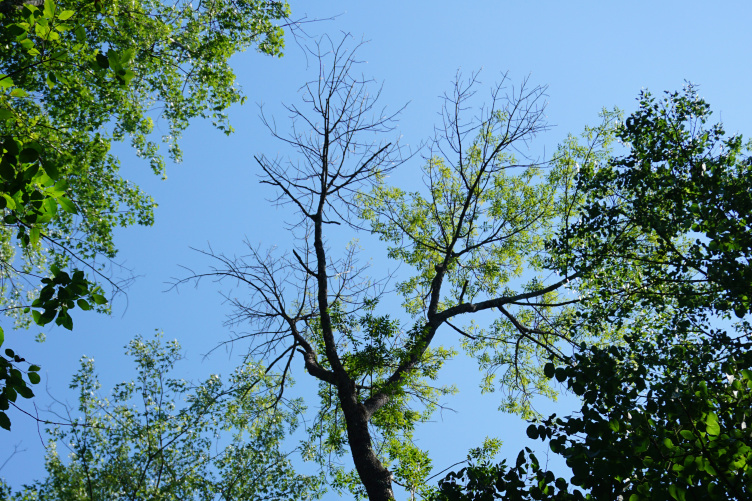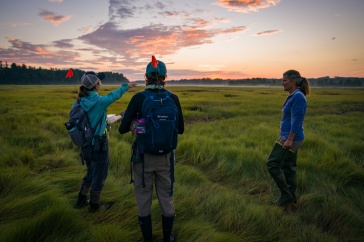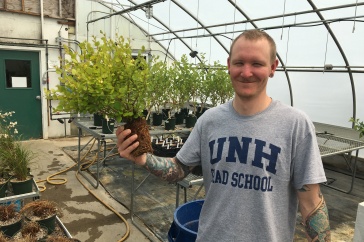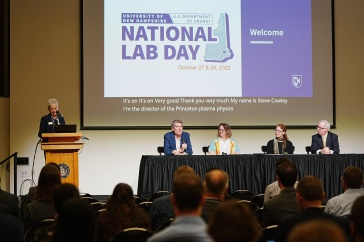
An ash tree infested with the emerald ash borer in Boscawen, New Hampshire
The emerald ash borer (EAB), a shiny metallic-green beetle smaller than a dime, has killed hundreds of millions of ash trees across the country and is now threatening to reshape New Hampshire’s forests and erode biodiversity.
Jeff Garnas, assistant professor of forest ecosystem health in the UNH College of Life Sciences and Agriculture, has been working to save ash trees from annihilation. Supported by a research team that includes graduate and undergraduate students, Garnas is testing the efficacy of a tiny parasitic biocontrol wasp (Latin name: Tetrastichus planipennisi) which lays its eggs inside EAB larvae, killing them.
The team is also assessing the ability of small ash trees in the forest understory to survive once the initial wave of beetles has passed through the state. The data Garnas collects will be vital for the development of sound, research-based forest management strategies to protect ash long-term.
EAB is a non-native insect from Asia that arrived in the U.S. in 2002. Without any natural enemies in North America to suppress its population, the beetle flourished among Michigan’s vulnerable ash trees and has since spread to 34 other states. Along with the trees themselves, one study estimates that 44 insects are at high or very high risk of extinction as a direct consequence of the EAB invasion.
The emerald ash borer is one of the more recent exotic insects to arrive in New Hampshire, and one of the most devastating,” says Garnas. “In the absence of these and other efforts, ash is highly likely to go the way of the American chestnut, which is to say that it will be effectively extirpated from North American forests.”
Along with the threats to biodiversity, there are also economic and cultural implications should ash trees, which account for 8 percent of the Granite State’s forest, die in large numbers.
In New Hampshire, stately ash trees line the streets of towns and cities and populate residential yards and parks. The rapid decline and death of these trees will be costly to homeowners, businesses and municipalities. The trees are also important to the region’s Native American tribes who have made intricately woven baskets from pounded black ash splints for generations.
But Garnas says that due to climate change and a global trade system that makes possible the spread of insects and pathogens to ecosystems all over the world, the problems forests face are even bigger than EAB. While forests show great capacity to rebound and regrow after disturbance, these non-native invaders pose a serious threat to the long-term health and productivity of these vital ecosystems.
“The emerald ash borer is certainly not the last and maybe not even the worst invasive insect likely to arrive in our forests,” says Garnas. “The ultimate path toward maintaining healthy forests lies in preventing the arrival of the next potentially devastating invader through sound trade and import regulations implemented at a national level.”
The Northeast region in general is a hotspot for invasive insects and pathogens, and in New Hampshire, at least 50 of these non-native invaders are currently impacting trees and woodlands.
“What my lab is really doing,” says Garnas, “is building research capacity around insects and pathogens that threaten the region’s forests to understand how living in a highly interconnected world is impacting the ecology and evolution of forest systems.”
This is no small matter in New Hampshire, which is roughly 83-percent forested and where woodlands are incredibly important to the state’s character and identity, to local economies and to the overall quality of life in the region. As Garnas puts it, “Threats like the EAB should serve as a wake-up call to all of us, and it is absolutely crucial that we take these threats seriously.”
-
Written By:
Sarah Schaier | College of Life Sciences and Agriculture



















































